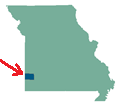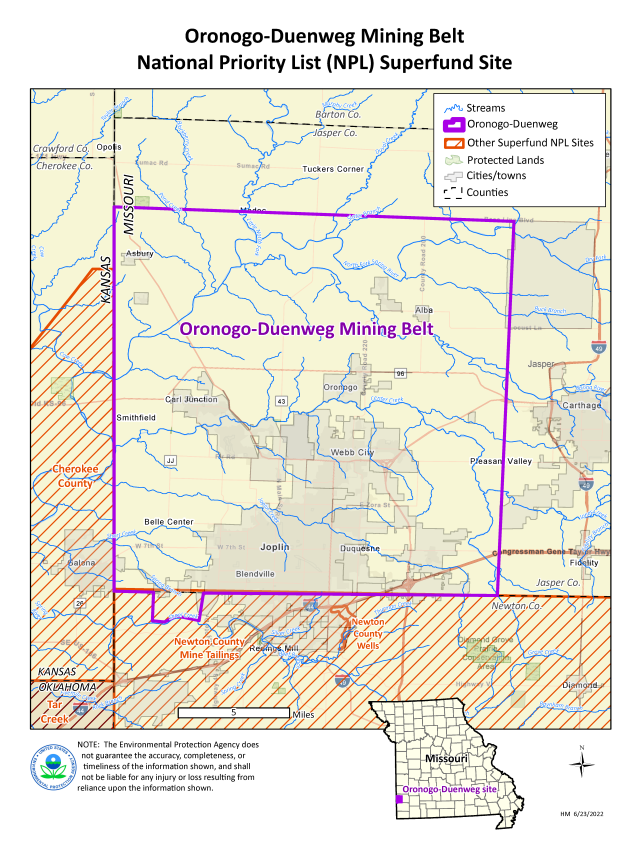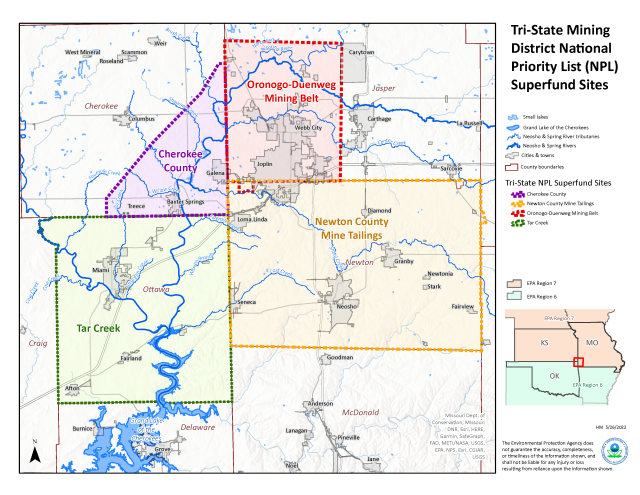Oronogo-Duenweg Mining Belt National Priorities List (NPL) Superfund Site, Jasper and Newton Counties, Missouri – Fact Sheet, August 2022
Remedial and Removal Actions Site Update
Site Overview and Update

The U.S. Environmental Protection Agency (EPA) Region 7 is testing for lead contamination in private drinking water wells, residential yards, and areas with suspected mining waste within the Oronogo‑Duenweg Mining Belt National Priorities List (NPL) Superfund Site (site) in Jasper County.
Lead mine waste was spread throughout the area from historic mining activities in the Tri-State Mining District (TSMD).
Contact EPA Today About FREE Lead Testing!

If your property is located within the site boundary (see map at right), EPA can test your yard and/or private drinking water well for FREE – including residential yards, private drinking water wells and other child high-use areas. Sampling is performed at no cost to property owners. Please contact EPA or EPA’s sampling contractor, Tetra Tech, for more information or to request your property be sampled.
- Call EPA toll-free: 1-800-223-0425
- Email EPA: [email protected]
- Call EPA's Soil Sampling Contractor, Tetra Tech: 620-284-1357
Site Background and Update
The Oronogo-Duenweg Mining Belt NPL Superfund Site is part of the Tri‐State Mining District where mining, milling, and smelting of lead and zinc ore began in the mid‐1800s and continued for more than 100 years. (See detailed maps below.) The site consists of numerous mine waste areas spread across hundreds of square miles in southwestern Jasper County, and part of northwestern Newton County, Missouri. Former mining and smelting operations contaminated soil, groundwater, and surface water sediments with lead, zinc, and cadmium. Millions of tons of surface mining wastes contaminated thousands of acres. The primary contaminants of concern at this site are lead, zinc and cadmium. After detecting elevated heavy metal levels in mine waste, soil, groundwater and sediment, EPA has been collaborating with the state of Missouri and the local community to clean up lead‐contaminated areas for over three decades. EPA added the site to the NPL in 1990.

EPA later divided the site into six Operable Units (OUs), as follows:
- OU0 – Sitewide Activities
- OU1 – Mine and Mill Waste
- OU2 – Residential properties, child care centers, and schools (located in former smelter areas)
- OU3 – Residential properties, child care centers, and schools (located in the vicinity of mining and milling wastes)
- OU4 – Groundwater
- OU5 – Spring River Basin
For more information, visit EPA’s Site Profile Page.
What Cleanup Activities Has EPA Done to Date?
The site includes mine waste contamination in several former mining areas. Sitewide, EPA remediated nearly 25 million cubic yards of mining wastes over thousands of acres, remediated more than 3,000 residential yards, and supplied over 500 homes with a clean, permanent source of drinking water. Approximately 14 miles of streams have been remediated across the site in recent years.
Current Site Status
EPA is currently working on Operable Unit 1 – Mine and Mill Waste; Operable Units 2 and 3 – Residential Yards; Operable Unit 4 – Groundwater; and Operable Unit 5 –Spring River Basin. Cleanup activities have also included removal actions, or short-term cleanups, such as residential yard remediation, to address immediate threats to human health and the environment. Past removal actions included cleanup of soils at six child care centers and 300 residences, in addition to providing bottled water to affected residences. New time-critical removal actions are currently underway to address newly identified residential yards with lead contamination. Early testing of private drinking water supply wells indicated that many wells were contaminated with lead, cadmium and zinc attributable to historical mining activities. EPA’s initial response action was to provide bottled water, treatment systems, or city water connections to residences with contaminated private drinking water supply wells. Cleanup of the upper groundwater has not been feasible, due to the way the groundwater flows through an extensive network of abandoned underground mines. Please contact EPA if you would like to have your well tested or to see if your well has been tested in the past.

EPA is currently developing a Remedial Investigation and Feasibility Study for OU5 – Spring River Basin to address surface water and sediment contamination from historic lead mining. In August 2022, EPA completed the Fifth Five-Year Review (FYR) of the site’s remedy. FYRs are conducted to evaluate the effectiveness of the cleanup activities to protect public health and the environment.
About Lead and Public Health
Lead is a toxic metal that is harmful if inhaled or swallowed. Lead can pose serious health risks at low concentrations, particularly to children under 7 years old, as well as to those who are pregnant or nursing. Lead can decrease mental development, especially learning, intelligence and behavior in children. Even low levels of lead in the blood of children can result in behavior and learning problems, hyperactivity, slowed growth, hearing problems, and anemia. Some effects of lead poisoning in a child may continue into adulthood. Adults exposed to lead can suffer from cardiovascular effects, increased blood pressure and incidence of hypertension, decreased kidney function, and reproductive problems (in both men and women).
It is important that children under 7 be tested annually, because lead-poisoned children do not always look or act sick. The only way to know if your child has elevated blood lead levels is to have their blood tested. Talk to your pediatrician, general physician, or local health agency about testing your child. To arrange for blood lead screening, please contact the Jasper County Health Department, 105 Lincoln St., Carthage, MO 64836; at 417-358‐3111 or online.
Local Partnerships to Protect Health

EPA Region 7 is the lead agency for site activities, and the support agencies are the Missouri Department of Natural Resources and the Missouri Department of Health and the Environment.
EPA provides ongoing funding to the Jasper County Health Department for lead health education and implementing programs to test and manage soils prior to new construction of homes and to prevent building on mining waste. These programs maintain the remedy and are reinforced by a county lead health ordinance.
Lead Information and Site Details
Document collections were developed by EPA to form a clear understanding of the decisions to take actions at a site. Site project information is available to the public at web repositories. The Administrative Record File (AR) contains technical documents from EPA’s response actions. To view more site information, ARs, FYRs, Records of Decisions (RODs), and other cleanup documents, visit EPA’s Site Profile Page (see Site Documents & Data). EPA also posts Fact Sheets for Missouri sites online.
More information about lead:
- ATSDR's Lead ToxFAQs™
- CDC’s Lead page
- EPA's Lead page
- EPA's Learn About Lead page
- EPA's Lead at Superfund Sites page
- See "Protect Your Family from Lead Hazards in Historic Lead Mining Areas" Fact Sheet online.
If you do not have internet access, you can view these documents online during normal business hours at the following locations:
EPA Region 7 Records Center
11201 Renner Blvd.
Lenexa, KS 66219
1-800-223-0425
Joplin Public Library
1901 E. 20th St.
Joplin, MO 64804
417-623-7953
Community Involvement
EPA will also continue to solicit input from the public during various phases of EPA’s actions at the site and provide opportunities for community involvement. Contact EPA for more information about community involvement and technical assistance at the site.
EPA Contact Information
If you have questions about this Fact Sheet, need additional information about the site, and/or would like to receive site updates, please contact EPA:
Elizabeth Kramer
Community Involvement Coordinator
U.S. EPA Region 7 (ORA/OPA)
11201 Renner Boulevard
Lenexa, KS 66219
Phone: 913-551-7186
Toll-free: 1-800-223-0425
Email: [email protected] or [email protected]
Liz Blackburn-Vigil
Remedial Project Manager
U.S. EPA Region 7 (SEMD/LMSE/MSRS)
11201 Renner Boulevard
Lenexa, KS 66219
Phone: 913-551-7899
Toll-free: 1-800-223-0425
Email: [email protected]
